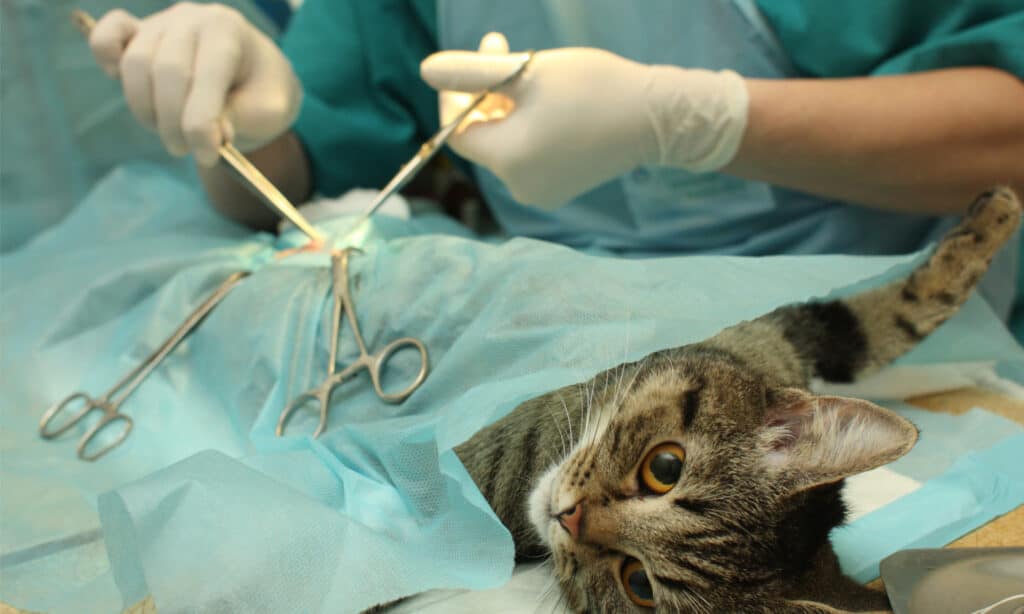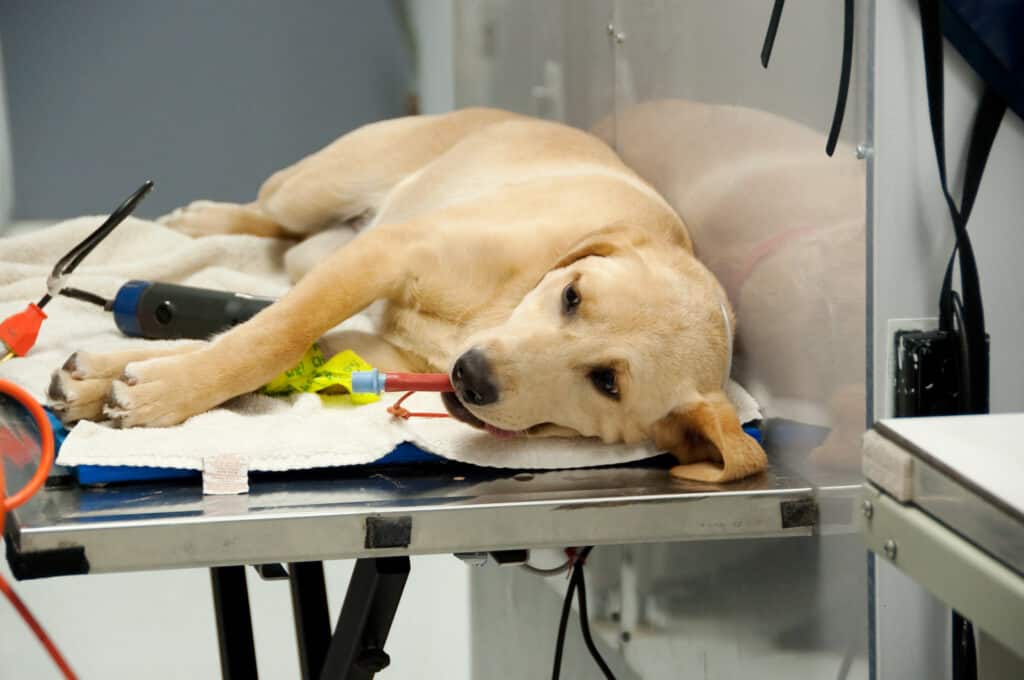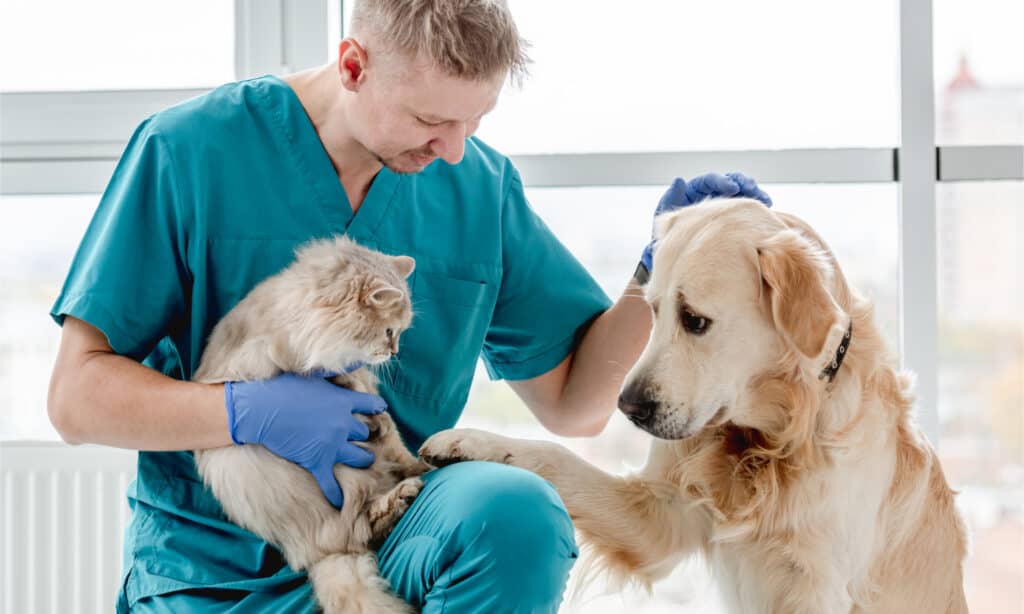Spaying and neutering are not mandatory in most states but are crucial in preventing further animal health issues. Each state will have laws regarding if spaying or neutering is required. If required, you must possess an unaltered-animal permit or health exemption from a veterinarian excusing the procedure. But what is the difference between a spay vs. a neuter?
As a pet owner, it’s essential to understand the role of spaying and neutering and if it’s the right choice for your animal. To understand this, we will first need to look at spaying vs. neutering and the difference between the two surgical procedures.
After that, we can examine how safe the procedure is and whether it’s a good option for your pet. Lastly, we will examine when owners should get their pets fixed and how it will impact the animal over time.
Spay vs. Neuter: The Difference

Animals need to be spayed or neutered if they are over the age of six months.
©iStock.com/DimaBerkut
Spaying and neutering are similar surgical procedures with only a tiny difference. The main difference is that spaying is done on females and is used to remove the ovaries. On the other hand, neutering is performed on males and removes the testicles.
Spaying
Spaying is performed on female animals and is a surgical procedure to help prevent the pet from getting pregnant or having a litter. The procedure involves removing the animal’s reproductive organs, including the ovaries and sometimes the uterus. This specific procedure is called an ovariohysterectomy.
It’s essential to get your female pet spayed because it prevents health issues in the future. The number one issue it prevents is an unplanned pregnancy. If you take your pet to a public place or have other animals of the opposite sex in your home, it’s crucial to protect against pregnancy. It only takes one time, and your pet will become pregnant, which comes with hefty costs.
Another benefit of spaying is that it helps prevent your animal from going into heat. When a female animal is in heat, it will attract the opposite sex. When this happens, it’s easy for them to become pregnant. In addition, animals may become more territorial and aggressive during this time.
Lastly, fixing your pet can help avoid any reproductive health issues. Those include uterine infections, cancers, and more. False pregnancies can also occur and alter an animal’s behavior. That’s why spaying your pet before there are negative health effects is important.
Neutering
Neutering is done on male animals and is a surgical procedure to help prevent the pet from impregnating other animals. It is also designed to help reduce certain behaviors and reduce the risk of reproductive issues.
The procedure consists of removing a male animal’s testicles. This procedure is called castration. Often, neutering is recommended for male animals as it helps reduce humping and mating behaviors.
However, it also can help reduce specific behaviors such as marking territory and dominance aggression. This should not be confused with changing overall behavior.
Many pet owners believe neutering a male dog will reduce all aggressive or anxious traits or behaviors. Instead, it works to help reduce testosterone production, which can help relax your dog and reduce mating aggression.
Neutering your pet also helps reduce the risk of testicular cancers and prostate health issues. In most states, it’s required that an animal over six months is neutered.
How Safe Is the Procedure?

Spaying and neutering is a safe procedure when conducted by professionals.
©aspen rock/Shutterstock.com
Spaying and neutering are relatively safe procedures with little risk if done by a professional. While we’d love to say it’s 100% risk-free, that isn’t the case. It’s still a surgical procedure that does have some risks involved. As a pet owner, you’ll want to be in the know about the dangers. Here are some considerations to keep in mind.
Preexisting Health Conditions

Certain health conditions might make spaying or neutering difficult. Be sure to bring up concerns to a veterinarian
beforethe procedure.
©Monica Click/Shutterstock.com
Not all animals can safely be neutered or spayed. A pet with preexisting health conditions might put them at risk for complications. Pets must be thoroughly examined before being scheduled for a spay or neuter appointment.
Always tell a veterinarian if there are known health issues or allergies. Also, listing any medications, supplements, or dietary restrictions your pet is on is essential. This information can be used to ensure that there won’t be any complications.
Some common health issues that could possibly make spaying or neutering difficult are:
- Obesity: obese pets have a higher risk of anesthesia-related complications as more fatty deposits reduce the drug’s safety.
- Heart disease: during surgical procedures, a pet’s heart can become compromised. Pets with weak hearts or cardiovascular impairments will be at risk.
- Respiratory problems: surgical procedures put stress on pets which can weaken them further. Animals with bronchitis, lung disease, or other respiratory illnesses are at risk during surgery.
- Bleeding disorders: Hemophilia, von Willebrand disease, or blood clots can be deadly if not addressed before surgery. Animals with these conditions will need special care and might not be eligible for spaying or neutering.
- Liver or kidney disease: kidney or liver issues impact medication and anesthetics and can increase complications during surgery.
- Diabetes: while not deadly, diabetes can cause an animal’s blood glucose levels to drop. Pets with diabetes need to be carefully monitored during surgery.
- Illnesses: sicknesses or illnesses can cause the pet to become weak. Veterinarians tend to ask owners to wait until any underlying conditions are treated before surgery.
- Elderly pets: older pets tend to have weaker bodies and reduced organ functions. This makes them susceptible to adverse anesthesia reactions.
Anesthetics
Anesthetics are used to help prevent pain and are used as a knock-out drug during surgical procedures. While this medicine is often safe, it does have slight risks.
Anesthetics can be deadly if the animal is allergic, has cardiovascular or respiratory illnesses, or has pneumonia. Aside from that, there is the risk of overdose or post-anesthetic complications that can be dangerous, such as delayed recovery.
Surgical Complications
Surgical complications include excessive bleeding, infections, and adverse reactions to the equipment used. While these complications are infrequent, they can still happen. A skilled veterinarian will do their best to mitigate these complications. So, it’s best to choose a qualified surgical veterinarian.
Postoperative Recovery

Following post-op instructions are crucial to your pet’s recovery.
©iStock.com/Daniel Besic
Post-op is the most critical time for a pet to heal. During this time, there are plenty of ways things can go wrong. Following the veterinarian’s post-op instructions are essential to prevent anything bad from occurring.
After surgery, animals risk complications such as infections. Providing medications as directed is essential, as missed antibiotics can lead to severe infections. In addition, make sure a pet doesn’t lick its stitches.
Spay vs. Neuter: When Should Pets Be Fixed?

Pets who reach over six months should get fixed unless they have underlying health issues.
©Tatyana Vyc/Shutterstock.com
Getting the right timing on when to fix a pet is crucial, but it can be different for each species. Generally, a pet should be spayed or neutered after becoming an adult. In addition, owners should know the cost of neutering or spaying a dog or cat. You should consider the following.
Age
The animal’s age comes into play when deciding to spay or neuter. Cats and dogs should be spayed or neutered within six to nine months. Despite this being the ideal time, dogs and cats can still be neutered or spayed after this timeframe. As long as they are healthy and have no underlying conditions that could be dangerous, then age isn’t a concern. The only factor is that a pet must be over six months or at maturity.
Weight
Another factor that veterinarians tend to factor in is the animal’s weight. Sometimes, a pet might not be at a healthy enough weight to be spayed or neutered. If this is the case, the vet might ask you to up their food intake or to wait until they are of a healthy weight.
While weight doesn’t seem like an essential factor, it is. Using anesthetics could be unsafe if a cat or dog is too tiny. In addition, it could also be dangerous, as the animal might not even be fully developed. Waiting until the animal is of a healthy weight and age is vital for the surgery’s success.
Heath
Health conditions might also prevent veterinarians from being able to spay or neuter a pet. For example, pets with a high risk of joint disorders or cancer should not be spayed or neutered. Uterine infections are also a factor. Dogs and cats who also experience high levels of anxiety might also not be a good fit.
Spay vs. Neuter: The Bottom Line
Spaying and neutering are the same type of procedure and should be done to help prevent pets from pregnancy. In addition, it can help animals become more docile and less territorial. That being said, there are still risks that an owner should be aware of.
Talking to a veterinarian can help determine if spaying or neutering is right for your pet. They may also be able to assist you with alternative procedures.
The photo featured at the top of this post is © SeventyFour/Shutterstock.com
Thank you for reading! Have some feedback for us? Contact the AZ Animals editorial team.







